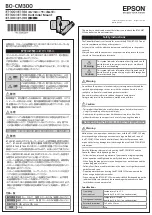
11
•
Exercise caution when handling the damaged battery and use suitable protective gloves. Dispose of the
battery in an environmentally friendly manner.
•
Never store damaged batteries in an apartment or in a house/garage. Damaged or swollen lithium bat-
teries may catch fire.
• Always use a compatible charger to charge lithium batteries and ensure that the charging specifications
are correct. Do not use NiCd, NiMH or lead-acid battery chargers, as these may cause a fire or explo
-
sion! Always select the correct charging specifications for your rechargeable battery.
•
Always use a balancer when charging a lithium battery with more than one cell (the charger comes with
a built-in balancer).
•
The charge rate for LiPo/Li-ion batteries must not exceed 1C (or the value stated in the battery instruc-
tions). This means that the charging current must not exceed the battery capacity (e.g. battery capacity
= 1000 mAh, max. charging current = 1000 mA = 1 A).
•
The discharge current must not exceed the value stated on the battery.
•
For example, if "20C" is printed on the LiPo/Li-ion battery, the maximum discharge current is 20 times
the battery's capacity (e.g. battery capacity = 1000 mAh, max. discharge current = 20C = 20 x 1000 mA
= 20 A).
•
Exceeding the maximum current may cause the battery to overheat or become deformed, which can
lead to a fire or explosion!
•
The printed value (e.g. 20C) indicates the maximum current that the battery can deliver for a short period.
The continuous current should not be higher than one half of the stated value.
•
Do not allow the individual cells of a lithium battery to become fully discharged. This may destroy the
battery or cause permanent damage.
•
If the model does not have overdischarge protection or a low battery indicator, stop using it before the
battery becomes empty.
Summary of Contents for Rocket Drone FPV
Page 1: ...Operating Instructions Electrical quadrocopter Rocket Drone FPV RtF Item No 1646409 ...
Page 41: ...41 ...
Page 42: ...42 ...
Page 43: ...43 ...




























![Navig[8]r NAV-RCDRONE15 User Manual preview](http://thumbs.mh-extra.com/thumbs/navig-8-r/nav-rcdrone15/nav-rcdrone15_user-manual_3573005-01.webp)



